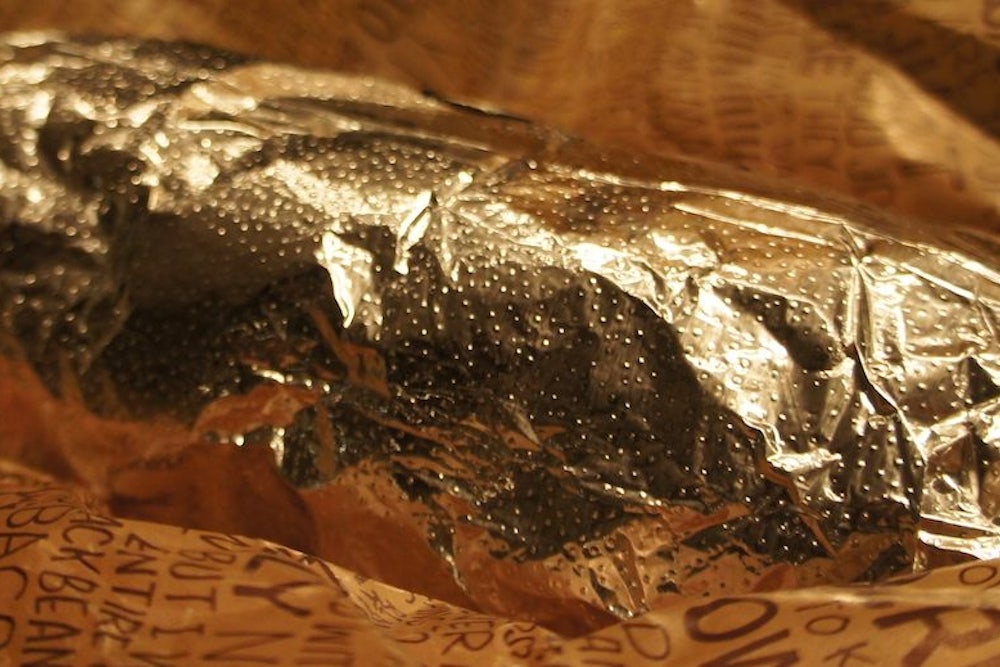Step away from the burrito.
It’s not your waistline I’m worried about. It’s lunchtime. Chipotle is ruining my favorite part of the workday (the part with no work). The problem isn’t the food: In many places, you won’t find a better burrito. My gripe is with the style of service. Lunch at Chipotle feels a little too much like the speed-slide at a roadside water park. Your friends all want to go there, just so you can endure a long line, rocket through the experience, and exit with a rumbling stomach.
Welcome to “fast casual” dining, the restaurant industry's term for a chain with better food than your typical fast-food joint and without the full service of a casual restaurant, like Applebee's. Chipotle's innovation has been to create a counter where each customer commands an assembly line of workers to manufacture his or her meal, ingredient by ingredient. Essentially, you’re paying a half dozen people to scoop the food out of the buffet trays for you. This style of service is spreading far beyond the flour tortilla. Chipotle runs a Southeast Asian chain in Washington, D.C. called ShopHouse and a pizza chain in Denver called Pizzeria Locale. There are Middle Eastern knockoffs like Roti and Chickpea, and salad spawn like Chop’t and Sweetgreen. My office’s neighborhood in Manhattan has two of the tastiest fast casual joints I’ve encountered: the Tex Mex-themed Tres Carnes and the Indian restaurant Indikitch.
“Everything in America is fast and casual,” John Heilpern, the “Out to Lunch” columnist for Vanity Fair, told me by phone. “I would prefer lunch was casual casual.”
Me too. The three-martini lunch may be embalmed on AMC, but lunchtime should still be leisure’s main foothold on our workdays. All that remains of the “lunch hour” is a few measly minutes, and Chipotle seems designed to make them as stressful as possible: long lines, pushy crowds, and time-pressured decisions. It's true the food, once you get it, is often better and cheaper than your average sit-down chain restaurant. But there's hardly time or space to enjoy it. As we have lost control over the length of our lunch break, Chipotle has tried to compensate us with more control over the particulars of the meal itself. So now many people’s idea of a satisfying lunch is one in which they make 50 rapid-fire choices about what they’ll eat: white rice or brown rice? Black beans or pinto beans? Pork, chicken, or steak? And that’s before you even get to the condiment trays. Chipotle claims its ingredients can be combined to create more than 65,000 different meals.
This may feel like empowerment to some people, but I find it exhausting. The pleasure of lunchtime is in taking a break from the decision-making of our professional lives. Better to make just one choice and enjoy the company you’re with, or the book you’re reading, until the food is ready. The current ethos, though, says you should take control yourself rather than trust a gatekeeper (in this case, a chef). So you end up in Chipotle, pinched between two suits, one who can’t make up his mind and the other policing the workers to make sure he gets full scoops of meat and guacamole.
That power to surveil the burrito-making process suggests a darker side to Chipotle’s popularity. “It’s impossible for me to look at a Chipotle during a busy time and not see a modern version of an assembly line,” Matt Yglesias once wrote—which means that, for a few moments, each customer is in control of the means of production. Could part of what Chipotle’s selling be a little bit of a power trip? Most people don’t call the shots back in the office, but at Chipotle you can play burrito baron.
“People really value being in control,” says Barry Schwartz, the author of The Paradox of Choice. “So it’s both about ‘I’m in charge here’ and about ‘I want a particular burrito.’”
It’s an illusion, of course: You’re paying for the burrito, not profiting from it, and additional control, like guacamole or extra meat, comes with a cost. Still, this side of Chipotle is palpable enough that a colleague says he avoids it because it makes him feel exploitative. The mechanics of the service industry, often tucked away in a kitchen, are put in plain sight of the customers. Maybe people in sit-down restaurants are willing to pay a premium to not have to look low-wage kitchen workers in the eye. I suppose you could argue that Chipotle, by bringing worker and consumer face-to-face, is actually doing the world a service. If there’s going to be a revolution, though, can’t it wait until after lunch?
